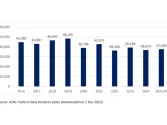Compliance work remains their strongest suit, but the way they do it drastically changed.
As clients shift their financial plans to make sure that their cash flow will withstand another few months of impact from the COVID-19 pandemic, accounting firms are still considered lucky enough that some services, such as auditing, remain essential and are just enough for them to stay strong amidst the storm. But even that has taken a turn that may change the process forever, further weighed by other services that took a severe hit.
In Hong Kong Business’ 2020 edition of the annual Accounting Rankings survey, PwC Hong Kong continues to take the helm in terms of having the largest number of employees in the industry, with around 4,600 employees as of 31 March. EY came in second place with about 3,250, followed by third placer Deloitte with around 3,000 employees. KPMG ranked fourth with an estimated 2,200, and rounding up the top five is BDO with 1,100.
Overall, the 23 largest accounting firms in Hong Kong have about 17,800 employees in 2020, which remained unchanged compared to the same period last year. Some firms have cut their headcount, whilst some hired more.
Comprehensive auditing
Even as these figures suggest that there is neither stability nor anything serious to dread, Hong Kong’s accounting scene is not out of the woods yet. Managing director of BDO Clement Chan stated that transaction-based services, such as M&A, due diligence and IPO activities, are badly hit as clients become more cautious on where they put their money into.
He also shared that they had long-term clients whose cash flows had suddenly dried up because of the abrupt stop of all economic activity. “They need us to give them a longer credit period at this difficult time. At times, we are faced with the extreme difficulty in balancing the need to collect fees before starting current year’s work so as not to compromise our independence and allow a longer credit period because of the cash-strapped situation of clients,” Chan said.
Thankfully, compliance services, like audit and tax, are keeping these firms afloat given that these services will always be required. However, firms revealed that there have been a lot of struggles in this area as well.
Prior to the events of COVID-19, accounting and auditing work would require their staff to travel to their clients’ offices and plants on a regular basis, and this field work had been crucial to accounting firms in Hong Kong as they have many clients based in Mainland China. These professionals have then begun to seek help from their mainland branches to do some of the work, stated Stephen Weatherseed, managing director of Mazars Hong Kong.
“With wide-ranging COVID-19 travel restrictions in place for an undetermined period, auditors are encountering unanticipated barriers to obtain the information needed to perform audit procedures and form conclusions when audited entities have operations in affected jurisdictions, or if there are financial reporting-related functions located therein,” said Roy Lo, managing partner of ShineWing.
Apart from increased workload because of the lockdowns implemented, RSM Hong Kong’s managing partner Eugene Liu stated that auditors became burdened with extra financial reporting considerations and facing challenges when conducting their audits. Lo further explained that accountants used to perform audits in the last two months of the financial year, but has now evolved to a continuous, year-long communication with clients.
As a result, auditors are required to perform additional procedures to better assess the management’s ability to continue their operations as a going concern, any asset impairment resulting from the direct impact of COVID-19, or the indirect impact of uncertainty in the business and wider economic environments.
However, BDO’s Chan reminded that “the work requirement will not change significantly as our regulators are rightly expecting the same quality of output and work from all stakeholders. It is really down to how one successfully renovates and evolves with new and better ways of doing things under the new environment.”
It then became fairly obvious that digitisation is the way to go forward. Weatherseed shared that in Mazars, they’ve upgraded their facilities and softwares to enable smoother internal and external communications. Ewan Clarkson, chief people officer at PwC mainland China and Hong Kong, stated that agility, leadership, and active communication across national, regional, and local businesses are critical to ensuring engagement, quality and execution addressing client needs throughout the period of social distancing and remote working.
“The event has accelerated our digital transformation journey, which involves implementing new workspace practices and getting the right technology infrastructure that enables collaboration while upholding compliance and regulation crucial for remote working,” said PwC’s Clarkson. He also added that apart from putting digital tools in place, they are also upskilling and investing towards a more agile, innovative and digitally-enabled workforce against emerging market demands.
Though most firms, especially the larger accounting firms, had always reiterated that modernising their operations was their main focus even prior to COVID-19, RSM’s Liu argues that these are not enough.
“We always need to deal with large data in person, remote communication for our staff and clients affects the effectiveness and the efficiency of the financial reporting and disclosure controls. Meanwhile, there are unique challenges for audit clients due to the COVID-19 and which may directly impact an auditor’s risk assessment and response,” Liu said.
Specifically, Liu stated that they were not able to do cross-border audit work, investigation, investment analysis and enterprise management. And as businesses halt operations or shut down, the accounting industry has suffered from a loss of clients.
“New businesses setting up in Hong Kong have dramatically slowed down, and whether its M&A transactions, or just general expansion of the businesses, or doing more businesses from one company to another, needing professional help at the back end of that have obviously slowed down as well,” Mazars’ Weatherseed added .
This, as a result, could then spill over to Hong Kong’s position as a global financial centre.
Cautious recovery ahead
Weatherseed believes that the demand for ongoing compliance work will still rise in the next few months. “I think there is likely to be more businesses that are going to be going out-of-business or finding financial difficulties. Then the shareholders, creditors or the investors, they're going to turn to accounting firms for assistance and advice and how to deal with those situations,” he said.
RSM’s Liu agrees. “There is an increase in consulting services. Uncertainty of COVID-19 created a large number of challenges for our clients on their operations, cash flow and the impairment of the assets etc. For instance, clients seek alternative financing options, transaction advisory and funding advisory to apply government funding, which can provide them a short-term cash flow,” said
Liu also added that more clients are also increasingly seeking advice on technology solutions and digital transformation given the pandemic. And even as accountants under M&A advisory have noticed that there are low to zero new clients, Mazars’ Weatherseed shared that they’ve been keeping busy from doing post-merger integration (PMI) work.
But looking ahead, ShineWing’s Lo is feeling optimistic on what the future holds for Hong Kong’s accounting scene. However, he warned that businesses should stay vigilant.
“We believe the market will gradually recover. However, in view of the business sustainability, businesses should develop and implement a contingency operation plan and risk assessment mechanism not only for the current pandemic but also any other occurrence of force majeure,” Lo said.
Further, Liu also clarified that even if things may get back to normal by end-2020, it won’t necessarily mean immediate return to growth.
“No one can accurately predict the future but many companies did take actions, such as reviewing portfolios to minimise the loss during COVID-19. It also means rebalancing portfolios of assets more frequently through acquisitions and disposals. Increase in demand on M&A is beneficial to accounting firms to address the incredible challenges,” Liu stated.



 Advertise
Advertise














Commentary
Strategic location tips for playgroups and education centres